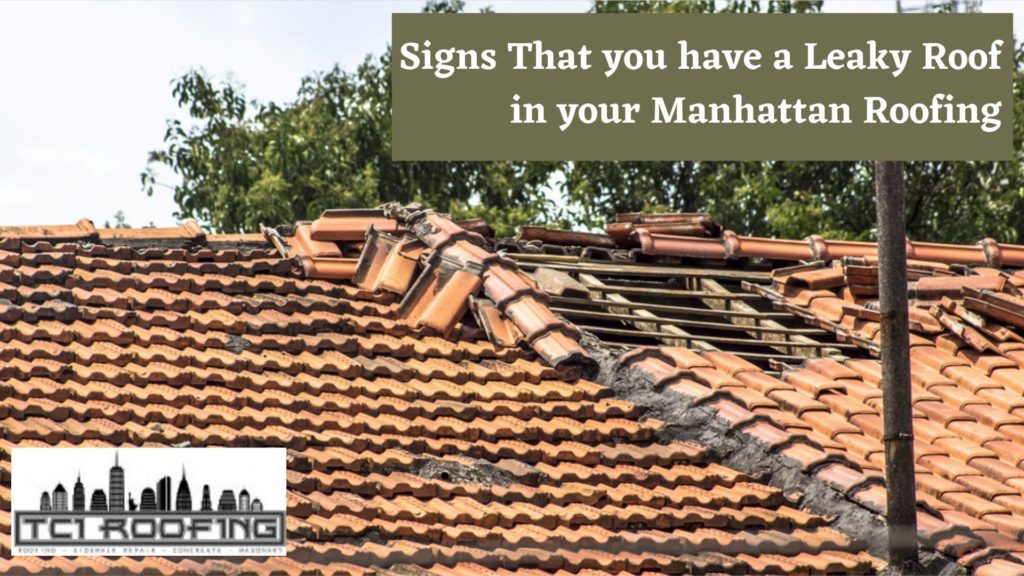If you are wondering if your Manhattan roofing is leaking, there are at least three signs that point to the answer. If you notice any of these signs that may worsen from roof sun damage and affects the cold weather, it’s best to call a roofing company in New York City immediately for the best roof repair. A leaky roof can lead to serious structural damage and mold growth inside your home which will cost much more than just getting it repaired or replaced.
The Obvious Signs on Your Manhattan Roofing
Your roof has been leaking for a long time if you’re setting up a bucket in the kitchen to collect rainwater. Your attic and roofing material, ceiling, and rafters may be harmed as a result of the leaks. It can also encourage the growth of mold and mildew, which can be harmful to one’s health.
While water flowing from the ceiling is a sure symptom of a leaking roof, you should not wait until then to determine whether there is a leak. Instead, keep your eyes peeled for earlier warning signs and may use roof sealants like silicone sealants, a liquid sealant, and other moisture-resistant materials then you may need roof repair.
Discoloration
Water will be absorbed into your ceiling before it starts leaking. Your roof will become discolored after drinking a large amount of water you need to have a roof repair.
Take a flashlight and study your ceiling thoroughly to see if there are any wet spots. Water damage will resemble coffee stains in appearance. If you’re looking for wet spots, don’t forget to look inside closets and in the basement. Always inspect the ceiling above tubs or appliances, as pipes often lead up to the roof.
Damage to Wood and Drywall
If the leaking persists, it may spread from the ceiling to the drywall in your home. Your walls’ structural integrity may be jeopardized as a result of this.
Look for signs of warping at the seams between your walls and ceiling. You might even notice areas that are starting to crumble or dust. In severe circumstances, entire drywall portions may even collapse. Additionally, you may observe damage to wood beams that contribute to the construction of your home. Wooden beams, studs, and joists can decay as a result of water damage needs to have roof leaks repair. The wood will need roof sealant or to be replaced if the damage continues.
Mold and Mildew
Water can become trapped in limited places if it leaks into your home. Humidity is created as the water level rises. Mold and mildew begin to grow in this atmosphere.
Mold can create respiratory difficulties for you and your family if it grows in your house. Look for black or dark patches that resemble a stain to check for mold. Also, make sure there is no mold in damp areas like the attic or basement.
Electrical Problems
If a leak is left unattended for a long time, it might cause harm to your home’s electrical system and roofing materials. Water may affect the wires themselves or your electrical circuit box, remove roof sealant depending on where the leak is located.
The majority of your home’s cables are comprised of copper, which erodes over time. If the damage is not repaired, wires may break or short out. In addition, the entire electrical system can be thrown off if the dripping water damages your home’s breaker box.
Storm Damage
If you have any reason to believe your entire roof may have been damaged, this is a sign that you should check for a potential leaky roof.
Storm damage can cause projectiles that dent your roof or can produce powerful winds that tear off shingles. If your area has been affected by a severe storm, you should inspect your roof afterward to ensure no damage.
Look at Your Shingles
It’s critical to pay attention to the shingles whenever you inspect your roof. Asphalt shingles are the most widespread in the United States. These are intended to keep rainwater off your top and protect it from wind damage. However, exposure to the outdoors will cause your shingles to deteriorate over time.
The shingles along the roof’s edge are frequently the first to be damaged. Keep an eye out for curling, chipped, or damaged shingles. In addition, a part of your roof may be missing multiple shingles in some circumstances.
Pipe Boots
The majority of houses have pipes that extend to the roof. If the lines pass through the top, they can cause leaks and other issues.
Most pipes have protective coverings called pipe boots to protect them from the elements. These are typically constructed of rubber or lead and have a 7-10 year lifespan. If one of these boots becomes damaged, you’ll need to repair it to avoid a leaky roof. Even if it is a wet or dirty roof or metal roof you may use the best roof sealants or a moisture-resistant material.
Check for Puddles
Water collects on your roof before it starts leaking from your ceiling. When you climb to the top of your roof, search for puddles where water has collected. This could indicate that your roof isn’t adequately channeling rainwater into gutters and away from the structure. If you notice puddles on your top, call a professional to determine what’s causing the issue. Metal “flashing” is used to cover brick chimneys, ensuring that water does not run down the chimney and into your home.
Caulking or tarring a chimney isn’t a good enough substitute for adequate flashing. Please make sure the seals are flush with the chimney by inspecting them with a roofer. If they aren’t, they’ll have to be resealed to avoid leaks.

